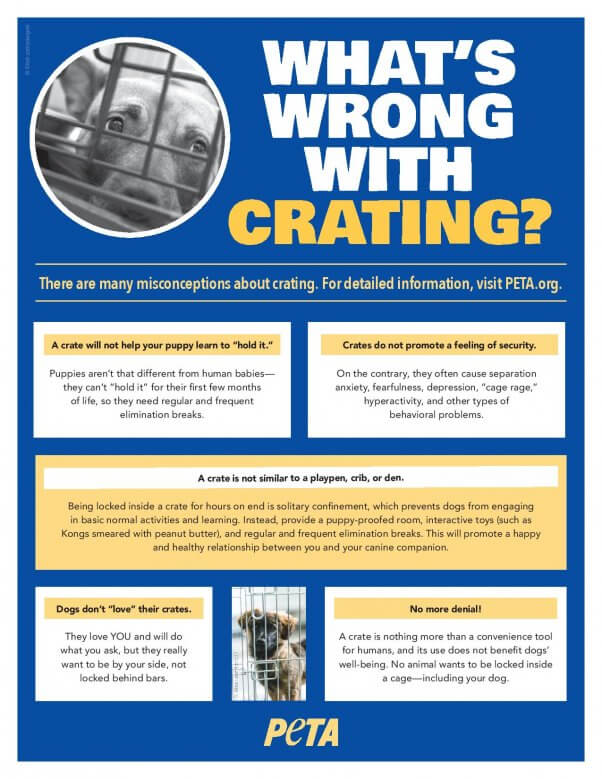Animal Rights Uncompromised: Crating Dogs and Puppies
No matter what a pet shop owner or dog trainer might say, a dog crate is just a box with holes in it, and putting dogs in crates is just a way to ignore and warehouse them until you get around to taking care of them properly.
Crating is a popular “convenience practice” that is often used on adult dogs. It deprives dogs of the opportunity to fulfill some of their most basic needs, such as the freedom to walk around, the opportunity to relieve themselves, and the ability to stretch out and relax. It also prevents them from interacting with their environment and learning how to behave in a human setting.
Crating began as a misguided way for people to housetrain puppies. The theory was that a dog in a small cage will “hold it” rather than eliminating, and dog owners would thus not have to pay close attention to their puppies while they were confined to the crate. It wasn’t long before dog trainers began recommending crating for adult dogs who had any type of behavior problem as a way of stopping the behavior. But this method does not teach dogs good behavior, and it certainly doesn’t take into account their social, physical, and psychological requirements. Dogs are highly social pack animals who abhor isolation and who crave and deserve companionship, praise, and exercise. Forcing dogs to spend extended periods of time confined and isolated simply to accommodate their guardians’ schedules is unacceptable, and it exacerbates behavior problems, leading to even more crating.
Housetraining Myths
Crate training does not speed up the housetraining process. Regardless of the training method, puppies do not develop full bladder control until they are about 6 months old. It is counterproductive to crate young puppies in the hope that they will “hold it.” They are physically incapable of doing so and are eventually forced to urinate in their crates after experiencing great discomfort while trying not to soil their beds. Puppies who repeatedly soil their crates often lose the urge to keep them clean, which prolongs and complicates the housetraining process.
Pet store and puppy mill puppies, who are born and raised in crate-like structures, tend to be difficult to housetrain, and they may experience severe anxiety and develop fearful and/or destructive behavior if they are confined to crates. They may even injure themselves while trying to bite or scratch their way out.
Crate Training Ramifications
- Aggression
- Withdrawal
- Hyperactivity
- Depression
- Eating disorders
- Obsessive licking
- Separation anxiety
- Inability to bond with humans
- Muscle atrophy
When there is a better, more humane way to train dogs, why would we subject our canine companions to a training method that is obviously not in their best interests?
PETA does not oppose keeping a dog confined to a small area as necessary if it is in the dog’s best interests (e.g., when complete rest is ordered by a veterinarian or when confinement will keep the dog safe during travel). In such cases, guardians should always take steps to ensure that dogs are provided with bedding and the opportunity to relieve themselves and that they are given access to water, fresh air, food, companionship, and other basic necessities.
Crating Alternatives for Working Guardians
There are numerous humane alternatives to crating for people whose work schedules require that they leave their canine companions at home during the day. PETA supports humane, interactive dog training, which promotes and teaches guardians effective ways to communicate with their animal companions. Committed caretakers who successfully complete training and continue to provide their dogs with rewards for good behavior can be confident that their dogs will not engage in destructive behavior while they are away.
For those who cannot make it home during the day to provide their dogs with a potty break and some attention, PETA recommends hiring a reputable pet service or soliciting a reliable person, perhaps a neighbor or relative, to take one’s dog out for a midday walk. A “doggie door” that provides access to a secure yard with a privacy fence is another option for giving dogs the opportunity to relieve themselves as well as for alleviating boredom and preventing neurotic behavior. Paper training can be another way to handle dogs’ need to relieve themselves when they can’t go outside. And having an animal friend to keep them company is another great option for keeping dogs stimulated and content while the human family members are away.



